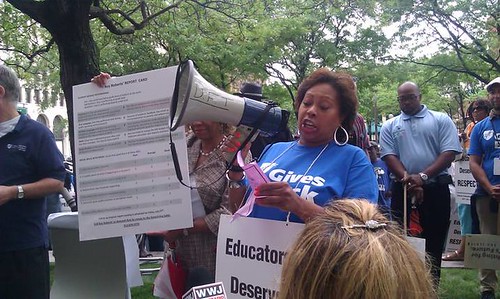
Detroit Federation of Teachers (DFT) Vice President speaks to hundreds of teachers outside the headquarters of the Emergency Manager for the school district. The teachers were protesting the imposition of a draconian contract. (Photo: Abayomi Azikiwe), a photo by Pan-African News Wire File Photos on Flickr.
US public schools continue to lose jobs
Thu Mar 14, 2013 4:55AM
presstv.ir
As the latest data shows momentum gathering in private-sector employment and overall unemployment dropping to a four-year low of 7.7 percent, government jobs - education positions in particular - are still disappearing as local government budgets remain pressured by the residual effects of the housing crisis and recession.
Since the peak in local public school employment in July 2008, about 361,000 jobs in the sector have been eliminated, roughly half of the 725,000 government jobs lost overall in the same period, Bureau of Labor Statistics data show. The losses are continuing, with 4,500 local government education jobs shed in the first two months of this year compared with 412,000 private-sector jobs created.
"When we looked at private-sector job loss, at first we were losing jobs, then we were losing jobs less fast, then we were adding jobs," said Heidi Shierholz, an economist at the liberal leaning Economic Policy Institute in Washington.
The 2013 figures signal local budgets are still in a slump. Money from the 2009 federal economic stimulus is gone and individual states have chipped away at funds they send to cities and counties. Meanwhile, property tax revenues, the main source of public school funding, remain low.
"Education is the largest or the second largest expenditure for states. When they need to cut their budgets, education and local aid are places they cut," said Naomi Richman, Moody's Investors Service managing director of public finance.
State spending on education dipped to 19.8 percent of total outlays in fiscal 2012, the first time it has accounted for less than 20 percent, according to the National Association of State Budget Officers. For many states, fiscal 2012 ended on June 30.
"I think it's very hard to say when you're going to see jobs start coming back in a really sustained way. It's particularly hard given the sequestration cuts are going to lead to additional job losses in education," said Michael Leachman, director of state fiscal policy at the liberal leaning Center on Budget and Policy Priorities.
Automatic government spending cuts totaling $1.2 trillion and spanning a decade, began this month and President Barack Obama has warned the first year of reductions totaling $85 billion will lead to cutbacks in education. Federal funds provide about 10 percent of public school budgets.
The White House estimates 10,000 teachers' and aides' jobs are at risk under the automatic spending cuts, referred to in Washington parlance as "sequestration." Up to 7,200 special education teachers and aides may no longer receive government funding.
Leachman said the first educators to be affected work on military bases and Native American reservations, because they receive direct federal funding. Other cuts will trickle into the budgets that states are crafting for their fiscal years starting July 1. That means many school districts will feel the squeeze at the start of the 2013-2014 school year. Reuters
FACTS & FIGURES
In contrast to gains in the private sector, a total of 33,000 federal worker jobs have been lost since January 2012 -- and that does not include jobs at the Postal Service, which is in the midst of a crisis of its own. CNN Money
Federal government jobs fell by 4,200 in February, the fifth month in a row those jobs have been zapped from the economy. And, thanks to the automatic budget cuts, it's going to get worse. CNN Money
More than half of the nation's 2.1 million federal workers could be furloughed over the next six months. The federal government is the country's single largest employer, with its employees making up about 1.2 percent of the nation's work force. AP
The U.S. Payroll to Population employment rate (P2P), as measured by Gallup, was 43.3% for the month of February, down from 43.6% in January. This also reflects a decline from the 43.6% P2P rate of February 2012, and is the lowest P2P rate since April 2011's 43.3%.
Underemployment was 18.1% in February, up from 17.5% in January. Gallup's U.S. underemployment rate combines the percentage of adults in the workforce who are unemployed with the percentage of those who are working part time but looking for full-time work.
1 comment:
Automatic government spending cuts totaling $1.2 trillion and spanning a decade, began this month and President Barack Obama has warned the first year of reductions totaling $85 billion will lead to cutbacks in education. Federal funds provide about 10 percent of public school budgets.
Media Monitoring
Post a Comment